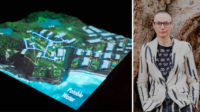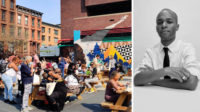For our June 2022 special feature on climate justice, RECORD spoke to changemakers in the field for a diverse array of perspectives on social justice and the climate emergency.
Elizabeth Yeampierre is the co-chair of the Climate Justice Alliance and the executive director of UPROSE, a community group focused on environmental justice in Sunset Park, Brooklyn. Her work at UPROSE centers around community organizing in Sunset Park, targeting large-scale sustainable development and tackling environmental issues that threaten historically marginalized populations. Since joining UPROSE in 1996, Yeampierre has contributed to efforts that have doubled the amount of open space in the neighborhood; in 2014, the community celebrated the opening of the 23-acre Bush Terminal waterfront park, the culmination of a 15-year effort by UPROSE.
Yeampierre has a law degree from Northeastern University and has previously served as director of Legal Education and Training at the Puerto Rican Legal Defense Fund, director of legal services for the American Indian Law Alliance, and dean of Puerto Rican student affairs at Yale University.
What is UPROSE and what is your role there?
UPROSE was founded in 1966 and has morphed into an intergenerational, matriarchal grassroots organization working at the intersection of racial justice and climate change. In 1996, the community came to us and was concerned about the expansion of the Gowanus expressway. They were complaining about asthma and living in a lead belt. That was our entry into environmental justice in response to what the community had articulated as a priority. We pivoted from that to fighting for open space, getting agreements to reduce net emissions, and then integrating a climate lens. What does community-based planning look like in the face of climate change? How can we take an industrial sector that has played a role in toxic exposure and is literally killing people in our community to become a vehicle for climate adaptation and mitigation? How can we start addressing renewable energy, food sovereignty, and all the needs of the local community using the sector that has been responsible for harming the community? So we went from fighting against things to operationalizing and transitioning everything to being community-owned: from a solar cooperative to offshore wind turbines, which are now going to be assembled at the South Brooklyn Marine Terminal.
What does environmental justice or climate justice mean to you?
That's not a personal definition. That's not a question that an individual even has the authority to answer. That is a definition that comes from the collective, from the frontline, from the people who have been working at the forefront of climate justice for a while. And so I have to honor that. I think in this country where the individual is more important than the collective, people feel entitled to redefine things and they don't get to do that. Environmental justice has to do with the disparate siting of environmental burdens in our communities, but it also speaks to leadership. The frontline speaks for itself and the climate justice movement is really about Black, Indigenous, and people of color fighting against a legacy of extraction and moving to a regenerative economy of different scales that honors our people and Mother Earth. And so within those, racial justice and equity is at the core, but so is leadership. Who leads these movements are the people who have been most impacted by climate change, the ones who are least responsible for creating it.
You've taken on these large-scale urban development projects on a community organizing level. What are the strategies for success in terms of bringing the people who are most affected to the front?
The strategy is to be multidimensional. You have to organize, and you have to be engaged in base building. You have to be engaged in popular education and you need to make sure that the tools are put in the hands of the people who are impacted. You need to be able to land policy and you need to be able to operationalize and literally put infrastructure on the ground. So it's not enough just to be aspirational; we need to be operational. We have to be able to work at all these different levels to ensure that the frontline vision is being funded and that we're passing the kind of legislation that puts a climate lens into zoning, land use, and funding, so that we can actually manifest this vision for a just transition in our community.
In terms of top-down initiatives, do you see anything that municipalities can do to promote environmental justice?
Municipalities have to engage in co-governance. Instead of using the patriarchal model of deciding what's in the best interest of communities, they need to have meaningful partnerships with communities because climate change is going to disrupt governance. And so it is really important that this idea of co-governance becomes integral in how decisions are made. It’s different from the way decisions have been made in municipalities—which is autocratic and top-down and often led with good intentions, but they haven't been intentions that have had traction.
What role have architects and urban planners played in the projects that UPROSE has taken on?
We work with architects and planners who understand participatory design and who are willing to use their discipline as a way to support local visions of infrastructure. Planners and architects can play a really important role in sharing the expertise, getting out of their silos, and using it as a way to advance community led visions. It's a different way of thinking than they've been trained in but it is what this moment demands. Those who have been able to do that have been the ones we've been able to work best with. And they're constantly learning different kinds of interventions that are beautiful and transformative. And they could, while listening to communities, say, “What about this? Does this serve your vision?” We get so excited about learning new things and applying different modalities to the vision that we have been holding for a while. So I think it's a win-win, but it really is about changing the culture of practice in the architecture and planning community.
You work within a specific area of Brooklyn. Can you identify the most urgent need that the community is facing right now in terms of the climate crisis?
Sunset Park is the highest elevation point in Brooklyn, and so I know that people talk a lot about sea level rise—because that's sexy and it's violent and you can see it—but it's really extreme heat that's going to kill a lot of our people. For those of us who are in an industrial waterfront community, it’s really important that there be investments in infrastructure. We want to take what is the largest significant maritime industrial area in New York to become a model of how an industrial sector that was bleeding jobs can pivot to a green economy and manufacturing—and, instead of following the market, creating the market for investing in food sovereignty, in clean water, in renewable energy, and in an industry that makes it possible to build for the challenges that climate change brings. It will prevent the local community from being displaced. It will be walk-to-work jobs that pay well. We need to engage in what we call deep green reindustrialization, and really reclaim these industrial sectors and have them be the economic vehicle for addressing our climate adaptation and mitigation needs. That's our priority.





Post a comment to this article
Report Abusive Comment